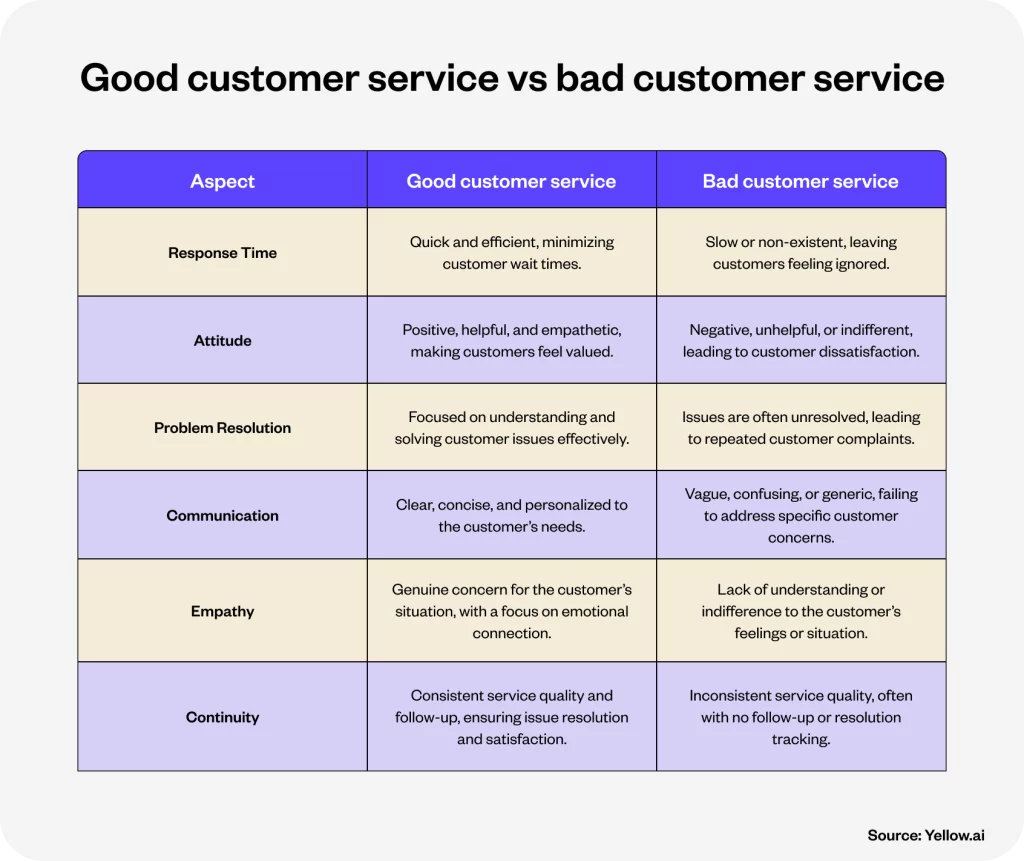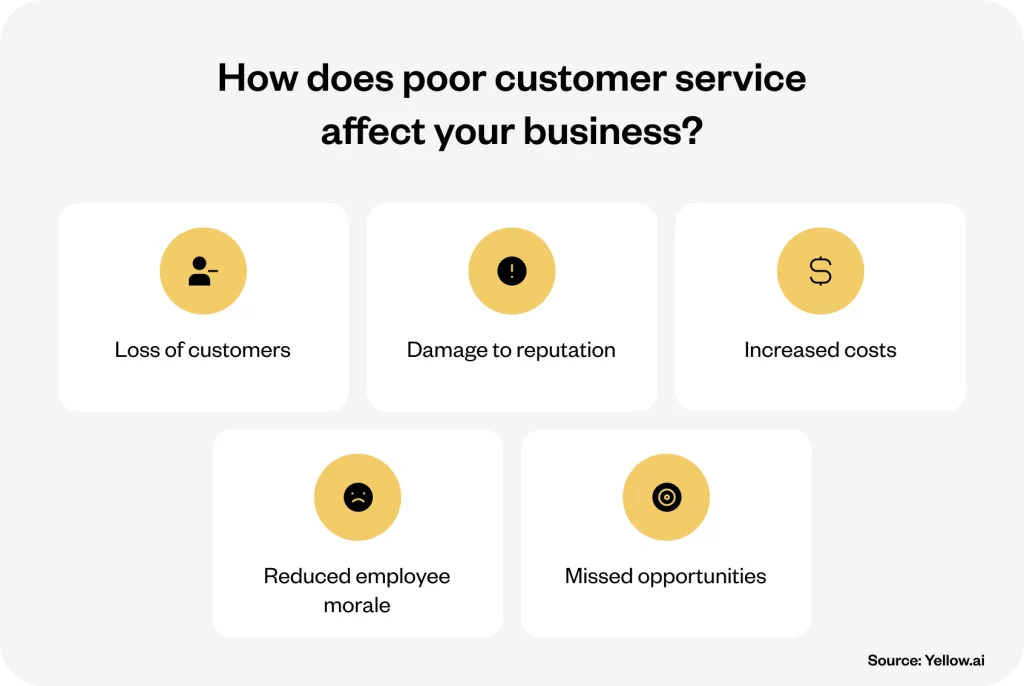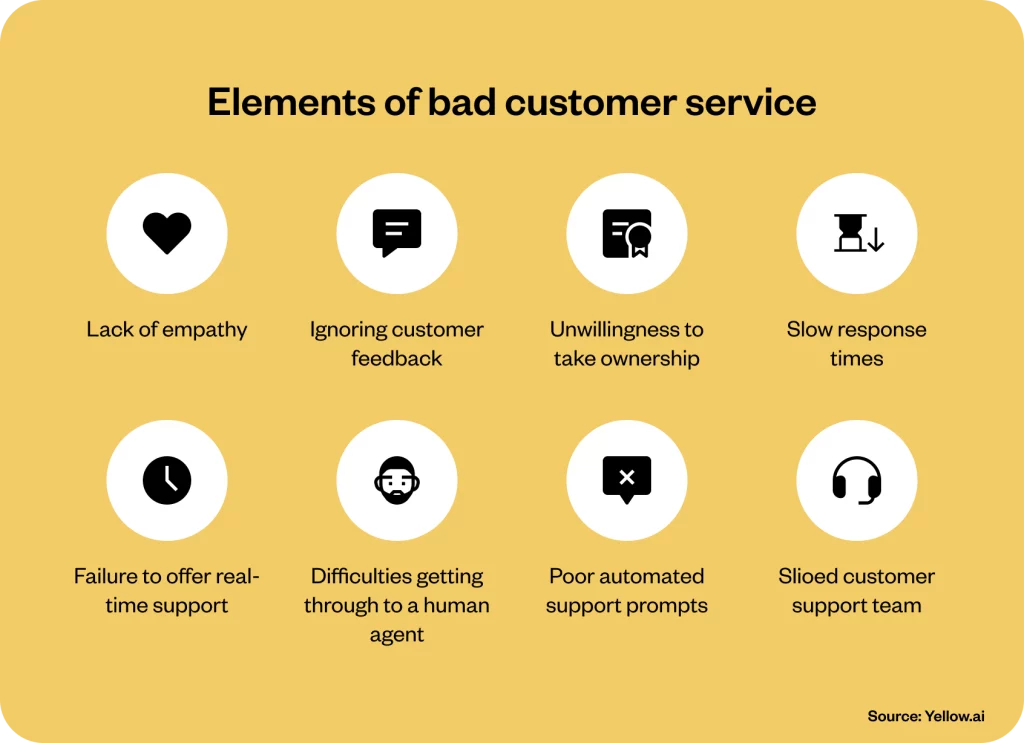Key Takeaways
- Poor customer service isn’t just a bad interaction, it’s a signal of deeper gaps in training, accountability, and culture.
- As customer expectations rise, slow replies or impersonal responses can quickly erode trust and satisfaction.
- Fixing the basics like empathy, ownership, and faster resolution, has a direct impact on loyalty and retention.
- In 2025, turning bad customer service moments into recovery opportunities is what separates reactive brands from resilient ones.
In a rush and need the TL/DR version?
Summarize
Bad customer service breaches the unspoken promise a business makes to its customers. Unpack the eight common customer service pitfalls and their strategic fixes to elevate your brand’s customer interactions.
Common customer service pitfalls and solutions:
- Empathy deficit: Boost customer relations by embedding emotional intelligence in your team’s skill set.
- Ignoring feedback: Treat every piece of customer feedback like a golden insight for continuous improvement.
- Shifting responsibility: Cultivate a culture of ownership where every team member resolves issues efficiently.
- Slow responses: Implement customer service automation to enhance responsiveness and reduce wait times.
- Lack of real-time support: Use live chat and AI-driven chatbots to provide 24/7 customer support.
- Difficulties with human interaction: Ensure seamless access to human support for complex issues alongside automated systems.
- Ineffective automated systems: Upgrade to advanced AI technology for smooth, intuitive customer interactions.
- Siloed support teams: Foster collaboration with integrated platforms that ensure consistent customer support across all channels.
Leverage advanced AI to turn customer service challenges into customer satisfaction victories.
Note: This summary is not a substitute for reading the article in full, as you may miss out on important nuances.
The impact of customer service cannot be overstated in the world of modern commerce. This blog ventures into the often-overlooked terrain of bad customer service. We’ll navigate through various bad customer service examples, analyzing the detrimental impact they have on businesses. By highlighting these examples, we aim to equip businesses with the knowledge to identify and rectify such issues, thereby elevating their customer service standards.
Introduction
Step into the shoes of a customer whose excitement turns to dismay in the face of subpar service. It’s a scenario far too common, yet each instance is a stark reminder of the delicate relationship between customer expectations and business realities. In today’s cutthroat market, the margin for error in customer service is razor-thin, and the cost of missteps can be monumental. The journey of understanding bad customer service is just like navigating a minefield, where each misstep can lead to lost loyalty and tarnished reputations.
Addressing bad customer service isn’t just about recognizing what went wrong. It’s about acknowledging mistakes, understanding their impact, and paving a path to improvement. Zendesk Customer Experience Trends Report 2021 found that 75% of people are willing to spend more on a brand with superior customer service. So, the message is clear.
But it’s not all doom and gloom. The following sections of this blog will talk about the anatomy of poor customer service, dissecting each element with precision. We provide a roadmap for businesses to transform their customer service from a weak link into a robust pillar of their organizational structure.
Related must-reads:
- A comprehensive guide to automating customer service
- Customer service strategy: A step-by-step guide
- 12 Customer service metrics to measure in 2024
- Customer service chatbots: Benefits and examples [2024]
What is bad customer service?
Bad customer service is a breach of the unspoken promise a business makes to its customers — the promise of meeting, if not exceeding, their expectations. This failure can manifest in various forms, all of which chip away at the foundation of customer trust and loyalty.
Bad customer service often involves long wait times, a sense of being undervalued, or encountering service representatives who seem disengaged or ill-equipped to address their needs. Imagine a customer, Jonathan, who calls for support and is trapped in an endless loop of automated responses, unable to reach a human voice. Or consider Nora, who emails a query and receives a response so late that it’s no longer relevant. These scenarios are not just annoyances — they are breaches of the customer’s trust.
What makes bad customer service particularly insidious is its ripple effect. A study by Consumer Reports highlights that 75% of shoppers are irritated by rude customer service reps, and 66% are frustrated by long hold times. These statistics are the voices of disenchanted customers, each echoing a story of disappointment. Moreover, with the omnipresence of social media, a single instance of poor service can rapidly morph into a public relations nightmare. It can amplify the impact of what might have initially been a minor oversight.
Understanding bad customer service involves understanding various factors. Often, it’s not just about an unhelpful response or a delayed reaction; it can be about an underlying lack of resources, training, or adequate technology.
Ultimately, bad customer service is when a business fails to walk in its customers’ shoes to see the world from their viewpoint. It’s when the focus shifts from ‘How can we help you?’ to ‘How quickly can we close this ticket?’. It’s a reminder that every business transaction requires human-like interaction, and failing to honor this can be the biggest misstep a business makes.
Good customer service vs bad customer service
Decoding the dichotomy between good and bad customer service is just like contrasting daylight with darkness. The differences are far beyond just operational. They are deeply rooted in the ethos and culture of a business. Good customer service is all about efficiency, empathy, and engagement, while bad customer service often strikes a disappointing note, marked by indifference and inefficiency.
Good customer service is the art of making every interaction with a customer an opportunity to build a lasting relationship. It involves prompt responses, an empathetic ear, and solutions tailored to individual needs.
Conversely, bad customer service is a terrible mix of frustration and disappointment. It is about long wait times, unresponsive interactions, and a general air of apathy. In bad customer service scenarios, customers are met with responses that feel scripted and impersonal, are transferred from one agent to another without resolution, or worse, encounter representatives who are dismissive or rude. These experiences fail to resolve the customer’s issue and also erode trust and loyalty.
Let’s break down the elements of each:

Remember, the distinction between good and bad customer service lies not just in the actions taken but in the intention behind these actions. Good customer service is genuinely wanting to help and connect with customers, while bad customer service often stems from a lack of interest or understanding of the customer’s perspective.
How does poor customer service affect your business?
Customer service forms the threads that bind customer loyalty, brand reputation, and operational efficiency. When these threads are strong, the business succeeds; when they fray, the entire fabric can fail. Unfortunately, poor customer service is a catalyst for this failure, impacting businesses in various ways.

1. Loss of customers
The most immediate and evident impact of poor customer service is the loss of customers. When customers feel undervalued or mistreated, they are likely to take their business elsewhere. Research indicates that it takes just one instance of bad service for 32% of customers to walk away from a brand. Another study revealed that over 54% of consumers have abandoned a purchase due to a poor service experience. This loss translates into immediate revenue loss and also affects future earnings through lost repeat business.
2. Damage to reputation
Reputation takes years to build but can be damaged quickly by poor customer experiences. Bad customer experiences often lead to negative reviews and social media posts, which can quickly go viral. Warren Buffet’s wise words resonate deeply here:
“It takes 20 years to build a reputation and five minutes to ruin it.”
The reputational damage from poor customer service can deter potential customers and tarnish the brand’s image, sometimes irreversibly.
3. Increased costs
Overlooking the value of quality customer service can be a costly mistake. It’s not just about the immediate hit on sales; it’s the longer-term financial strain that really adds up.
Think about it: wooing a new customer demands more investment than keeping a current one satisfied. Plus, the resources poured into fixing service snafus – be it time, workforce, or money – can chip away at your profits. This dual impact of increased operational expenses and dwindling customer loyalty is something no business can afford to ignore.
4. Reduced employee morale
The effects of poor customer service also permeate internally, impacting employee morale. Employees who are constantly dealing with dissatisfied customers can experience increased stress and job dissatisfaction. This environment can lead to high employee turnover, which in turn incurs training costs and loss of valuable experience and skills within the team.
5. Missed opportunities
Every customer interaction is an opportunity to strengthen the relationship and gather valuable insights. Poor customer service means missed opportunities to connect with customers, gather feedback, and improve products or services. It hinders the ability to create advocates out of customers who, if satisfied, could have promoted the brand through positive word-of-mouth.
Addressing the pitfalls of subpar customer service is more than just about firefighting problems as they arise. It is actually about adopting a proactive approach that places customer satisfaction at the core of business operations. Let us now explore specific examples of bad customer service and offer strategies for effective resolution and prevention.
Elements of bad customer service and here’s how you can fix them
Navigating through the pitfalls of subpar customer service can be enlightening. Here are some common examples and how businesses can address them effectively.

1. Lack of empathy
Empathy is crucial in understanding and connecting with customers. When service representatives fail to show genuine concern for customers’ feelings or situations, it leaves the customers feeling undervalued and dissatisfied. Imagine a customer, Sarah, calling to report a defective product. The representative responds mechanically, without acknowledging her frustration or inconvenience. Sarah feels her concerns are ignored, leading to a negative perception of the company.
How to fix – Embrace the art of listening
Empower your team to become masters of empathy by embedding emotional intelligence into their skill set. Through dynamic role-play and empathy training, encourage them to genuinely engage with and understand customer emotions. This isn’t just about solving problems—it’s about making each customer feel truly heard and valued throughout their interaction.
2. Ignoring customer feedback
Active engagement with customer feedback is essential for continual improvement. When businesses ignore feedback, they miss out on crucial insights and demonstrate a lack of commitment to customer satisfaction. For instance, a customer, John, leaves a detailed review about a service issue on the company’s website but receives no acknowledgment or response. This lack of engagement makes John feel his opinions are unvalued and ignored.
Related read: Customer sentiment analysis in 2024: How-to guide
How to fix – See your customers as the co-creator’s of your success
Initiate an active listening campaign within your organization, ensuring every piece of feedback is treated as a golden nugget of insight. By implementing a structured approach to engage with, appreciate, and act upon customer suggestions, your business can foster a culture where feedback is not only welcomed but is also a catalyst for growth and improvement. This strategy underscores a respect for customer perspectives, making them feel valued and part of your journey towards excellence.
3. Unwillingness to take ownership
Customer service excellence requires taking responsibility for resolving issues. An unwillingness to take ownership and the tendency to push things to the next level or next department’s court, can escalate customer dissatisfaction and erode trust. For instance, Emily contacts support about a billing error but is shuffled between departments, it becomes a hot potato no one catches. This runaround would quickly increase her frustration and diminish her trust in the company.
How to fix – Catch the hot potato
It’s crucial to foster a culture of ownership. Empower your team with the tools and the authority they need to tackle problems head-on. Encourage them to see each challenge through from start to finish, making resolution their mission. This approach doesn’t just solve problems; it rebuilds trust and transforms customer experience from frustrating to fulfilling.
4. Slow response times
Customers expect timely responses in today’s fast-paced world. Slow response times can lead to increased frustration and the perception that a business does not value its customers’ time. For example, Mike sends an email inquiry about a product and waits over a week for a response. This delay makes him feel neglected and pushes him to consider other providers.
How to fix – Get furiously fast
Elevate your response efficiency by integrating advanced AI-powered solutions such as Yellow.ai that can significantly increase your deflection rate by swiftly addressing queries with minimal-to-no human intervention, thereby and reducing resolution times dramatically. This approach not only demonstrates a commitment to respecting customer time but also leverages the latest in automation to ensure that every customer, like Mike, feels promptly attended to and valued.
5. Failure to offer real-time support
Immediate assistance is often critical in customer service. A failure to provide real-time support can exacerbate issues and lead to increased customer dissatisfaction. Consider this: A customer, Alex, encounters a problem with an online booking system but finds no immediate support available. His urgent issue remains unresolved, leading to a missed booking and heightened frustration.
How to fix – Always-on support
Implement live chat support and AI-driven chatbots for 24/7 assistance, and other advanced omnichannel solutions to ensure help is always at the fingertips of customers like Alex. These solutions provide round-the-clock assistance, adeptly managing routine inquiries and seamlessly escalating more complex issues to human agents. This blend of technology and personal touch not only resolves issues efficiently but also significantly enhances customer satisfaction by offering real-time, dependable support.
Did you know: We have just launched generative AI-powered EmailAutomation for instant and scalable customer support. With 4.2 billion email users and an average response time of customer service emails being 12+ hours, our email automation solution has been designed to:
✅ Understand complex emails
✅ Provide resolutions from a knowledge base
✅ Personalize responses to user insights
Learn more
6. Difficulties getting through to a human agent
Automated systems, while efficient, should not replace the option to speak with a human agent. Difficulty in reaching a human for complex issues can lead to customer dissatisfaction. Suppose a customer calls customer support and is trapped in an automated loop without the option to speak to a representative. In that case, the customer’s frustration mounts as they struggle to resolve a complex issue that requires human assistance.
Related read: AI agents: types, benefits, and examples
How to fix – Give the best of AI + Humans
While for the sake of efficiency and speed, you must invest in intelligent and human-like AI-powered solutions that are able to resolve a large chunk of tickets without human intervention. It is important to ensure your automated systems include a clear and easy option to connect with a human representative, when needed. Regularly review your customer journey to identify and eliminate such barriers depending on the biggest frustration points of your customers.
7. Poor automated phone prompts
Overly complex or malfunctioning automated phone systems can frustrate customers and create a negative experience. For instance, a customer calls customer service and is met with a confusing array of automated prompts that do not address his specific issue. His call is eventually dropped after a lengthy and unproductive wait.
How to fix – Get over tech that’s ‘so last season’
Transition from outdated IVRs and legacy chatbots to advanced generative AI technologies, which offer a more natural, human-like conversation flow. These next-gen systems understand and navigate customer queries with a level of finesse reminiscent of human agents, significantly improving the automated interaction experience. Regular updates and user experience testing ensure these systems remain efficient, user-friendly, and capable of elegantly guiding customers to solutions, elevating the overall service quality.
8. Siloed support teams
When customer support teams operate in silos, the lack of communication and collaboration can significantly hinder their efficiency and degrade the quality of customer service. This fragmented approach often results in customers receiving inconsistent information or having to repeat their issues multiple times to different team members, escalating their frustration and eroding trust in the brand.
How to fix – Make customer experience everyone’s business
To combat this, fostering a culture of collaboration and open communication across all support channels is essential. Investing in cross-training can equip your team members with a broad understanding of various issues, enabling them to provide consistent and accurate responses. Additionally, implementing a unified customer service platform can ensure that all team members have access to the same information, facilitating a more cohesive and efficient resolution process. This strategic shift not only streamlines support operations but also significantly improves the overall customer experience.
Why leverage Yellow.ai to automate your customer service?
Yellow.ai is an AI-first, unified customer service automation platform designed to deliver exceptional customer experiences across channels. It’s not only easy to set up but also fine-tunes itself to your enterprise’s operational tempo. It’s a blend of intuitive design and intelligent automation, handling customer queries across multiple channels with speed and precision. The platform stands out by allowing you to either leverage it for your end-to-end customer service needs, or seamlessly integrate it with your existing tech stack, thereby making it a solution that is both cost-effective and value-centric. Here’s why you Yellow.ai would make sense for your enterprise:
Efficiency boost: Automation propels efficiency, tackling low deflection rates and lengthy wait times. Customers enjoy up to 90% of queries answered promptly, resulting in a 35% reduction in handling times and a 60% decrease in costs. Did you know, Bajaj Finserv has been able to achieve $16M annual savings with Yellow.ai.
Ease of use: Deploy scalable solutions with ease, circumventing the need for specialized training or coding. The technology enables a 50% quicker market entry. Randstad’s 4-week setup exemplifies the swift adoption rate.
Power of bleeding-edge AI: Our platform’s multi LLM architecture ensures accuracy and speed, minimizing response errors to under 1%, with an impressive 0.6 second average response time, leading to a 50% uptick in conversions, while ensuring enterprise-grade security standards like ISO and GDPR are standard. Oona‘s and Pelago‘s gen AI-powered experiences showcase the high volume of interactions managed effectively.
“By bringing in Yellow.ai’s proven efficiency and next generation technology, OONA Insurance has elevated the current process into an easy, straightforward and wonderful experience for our customers,” Abhishek Bhatia, CEO, Oona Insurance.
Custom Integration: Customizable integration meets diverse needs, achieving 80% issue resolution with existing infrastructure. FerrellGas benefited from integrating with Salesforce CRM with Yellow.ai, facilitating over 30K order placements seamlessly.
Enhanced customer experience: Deliver a cohesive customer journey across 35+ channels, fostering a 60% increase in engagement and a 40% improvement in satisfaction. Hyundai was able to sell upwards of 1K cars through targeted omnichannel approach powered by AI automation.
Case study: Yellow.ai in action
Pelago reimagines customer experience with generative AI powered automation
Pelago, a trailblazer in the travel experience platform sector established by Singapore Airlines Group, tackled the challenge of handling a high volume of customer inquiries related to travel planning and bookings. The introduction of Yellow.ai’s Generative AI-powered travel assistant marked a revolutionary step in automating customer interactions. This AI solution facilitated goal-oriented conversations, providing personalized planning experiences and handling various customer needs from itinerary planning to post-booking queries, including cancellations and live support, across multiple channels like their website and WhatsApp.
Final thoughts
As we conclude, it’s evident that the world of customer service is evolving rapidly. The line between good and bad service is not just drawn by the quality of response but by the intent and technology behind it. Businesses now have the opportunity to turn every customer interaction into a positive experience, fostering loyalty and trust. With the right approach, supported by advanced solutions like those offered by Yellow.ai, companies can navigate the challenges of customer service and emerge as leaders in customer satisfaction.
Don’t just keep pace with customer expectations—set the pace with unmatched customer service.

Frequently asked questions (FAQs)
How can bad customer service affect a business?
Bad customer service can lead to a significant loss of customers, tarnish a company’s reputation, increase operational costs, reduce employee morale, and result in missed opportunities for customer engagement and feedback.
What are the common causes of bad customer service?
Common causes include lack of empathy, inadequate training, inefficient response systems, failure to prioritize customer feedback, and not utilizing technology effectively for customer engagement.
How can I identify if my business is providing bad customer service?
Indicators of poor customer service include high customer churn rates, negative feedback on social media or review platforms, long response times, frequent complaints, and low customer satisfaction scores.
How can training help in reducing bad customer service?
Regular and comprehensive training can enhance the skills and knowledge of customer service teams, leading to more efficient problem resolution, improved communication, and greater empathy towards customer needs.
How should businesses handle customer complaints about bad service?
Businesses should respond promptly and empathetically to customer complaints, take responsibility for mistakes, offer practical solutions or compensation, and use the feedback to improve their service offerings.






















